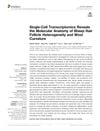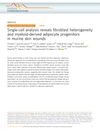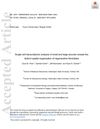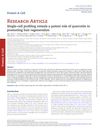Search
forLearn
5 / 8 resultslearn Osteopontin
signaling protein that, when suppressed, may grow hair by reducing inflammation and stem cell loss
learn Epidermal Growth Factor
learn Follistatin
glycoprotein that inhibits TGF-β and promotes hair growth by antagonizing activin
learn Thymosin Beta 4
Research
5 / 1000+ results
research Single-Cell Transcriptomics Reveals the Molecular Anatomy of Sheep Hair Follicle Heterogeneity and Wool Curvature
The research identified genes that explain why some sheep have curly wool and others have straight wool.
research Cell-Cell Interaction in the Hair Follicle Niche in Androgenetic Alopecia
New drug targets for hair loss treatment were identified by studying cell interactions in hair follicles.

research Single-Cell Analysis Reveals Fibroblast Heterogeneity and Myeloid-Derived Adipocyte Progenitors in Murine Skin Wounds
The research found that different types of fibroblasts are involved in wound healing and that some blood cells can turn into fat cells during this process.

research Single-Cell Transcriptomic Analysis of Small and Large Wounds Reveals the Distinct Spatial Organization of Regenerative Fibroblasts
Different types of skin cells are organized in a special way in large wounds to help with healing and hair growth.

research Single-Cell Profiling Reveals a Potent Role of Quercetin in Promoting Hair Regeneration
Quercetin significantly helps hair growth by activating hair follicles and improving blood vessel formation around them.
Community Join
5 / 1000+ resultscommunity A Nuanced Look at Microdosing Topical Finasteride
The conversation discusses using a low dose of topical finasteride to achieve hair benefits with minimal systemic exposure. Users share experiences and opinions on dosing, systemic buildup, and side effects of both topical and oral finasteride.
community Polydopamine Synergizes with Quercetin Nanosystem to Reshape the Perifollicular Microenvironment for Accelerating Hair Regrowth in Androgenetic Alopecia.
A quercetin-encapsulated and polydopamine-integrated nanosystem (PDA@QLipo) shows promise for treating androgenetic alopecia by reshaping the perifollicular microenvironment, outperforming minoxidil in hair regeneration. The nanosystem promotes cell proliferation, hair follicle renewal, and recovery by scavenging reactive oxygen species and enhancing neovascularity.
community Scientists May Have Accidentally Found a Way to Reverse Hair Loss Without Drugs
2-deoxy-D-ribose is being explored as a hair loss treatment but is not proven effective in humans and may be costly and inconvenient. Minoxidil remains the most effective treatment.

community Compressed part of research of theory of androgenic/anabolitic balance. AGA h-responders analytic. Theory of physio-metabolitic method of anti AGA treatment
The treatment for androgenetic alopecia involves using finasteride and minoxidil with intense exercise and cold exposure to boost metabolism and reduce androgenic effects, potentially leading to hair regrowth. This approach may activate biological pathways for improved hair and overall health.
community 8 years of hair loss, turning 30 next month
The user has been dealing with hair loss for 10 years, worsened by psoriasis, and uses minoxidil and finasteride. They seek advice on managing psoriasis and hair loss, with suggestions to see a dermatologist, try different shampoos, and be patient.